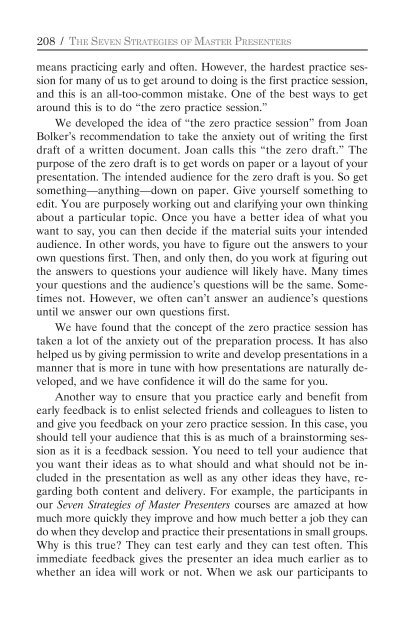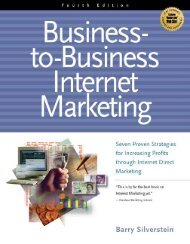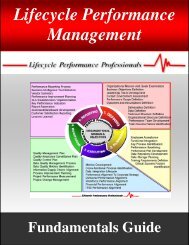The Seven Strategies of Master Presenters - Lifecycle Performance ...
The Seven Strategies of Master Presenters - Lifecycle Performance ...
The Seven Strategies of Master Presenters - Lifecycle Performance ...
Create successful ePaper yourself
Turn your PDF publications into a flip-book with our unique Google optimized e-Paper software.
208 / THE SEVEN STRATEGIES OF MASTER PRESENTERS<br />
means practicing early and <strong>of</strong>ten. However, the hardest practice session<br />
for many <strong>of</strong> us to get around to doing is the first practice session,<br />
and this is an all-too-common mistake. One <strong>of</strong> the best ways to get<br />
around this is to do “the zero practice session.”<br />
We developed the idea <strong>of</strong> “the zero practice session” from Joan<br />
Bolker’s recommendation to take the anxiety out <strong>of</strong> writing the first<br />
draft <strong>of</strong> a written document. Joan calls this “the zero draft.” <strong>The</strong><br />
purpose <strong>of</strong> the zero draft is to get words on paper or a layout <strong>of</strong> your<br />
presentation. <strong>The</strong> intended audience for the zero draft is you. So get<br />
something—anything—down on paper. Give yourself something to<br />
edit. You are purposely working out and clarifying your own thinking<br />
about a particular topic. Once you have a better idea <strong>of</strong> what you<br />
want to say, you can then decide if the material suits your intended<br />
audience. In other words, you have to figure out the answers to your<br />
own questions first. <strong>The</strong>n, and only then, do you work at figuring out<br />
the answers to questions your audience will likely have. Many times<br />
your questions and the audience’s questions will be the same. Sometimes<br />
not. However, we <strong>of</strong>ten can’t answer an audience’s questions<br />
until we answer our own questions first.<br />
We have found that the concept <strong>of</strong> the zero practice session has<br />
taken a lot <strong>of</strong> the anxiety out <strong>of</strong> the preparation process. It has also<br />
helped us by giving permission to write and develop presentations in a<br />
manner that is more in tune with how presentations are naturally developed,<br />
and we have confidence it will do the same for you.<br />
Another way to ensure that you practice early and benefit from<br />
early feedback is to enlist selected friends and colleagues to listen to<br />
and give you feedback on your zero practice session. In this case, you<br />
should tell your audience that this is as much <strong>of</strong> a brainstorming session<br />
as it is a feedback session. You need to tell your audience that<br />
you want their ideas as to what should and what should not be included<br />
in the presentation as well as any other ideas they have, regarding<br />
both content and delivery. For example, the participants in<br />
our <strong>Seven</strong> <strong>Strategies</strong> <strong>of</strong> <strong>Master</strong> <strong>Presenters</strong> courses are amazed at how<br />
much more quickly they improve and how much better a job they can<br />
do when they develop and practice their presentations in small groups.<br />
Why is this true? <strong>The</strong>y can test early and they can test <strong>of</strong>ten. This<br />
immediate feedback gives the presenter an idea much earlier as to<br />
whether an idea will work or not. When we ask our participants to










